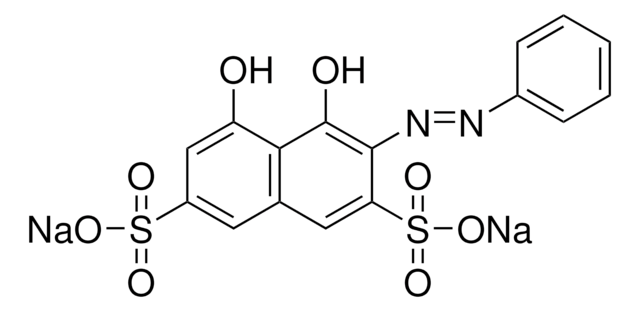79690
Phosphotungstic acid hydrate
for microscopy
Sinónimos:
Tungstophosphoric acid
About This Item
Productos recomendados
grade
for microscopy
Quality Level
form
powder or crystals
impurities
≤0.002% total nitrogen (N)
loss
≤15% loss on drying
pH
2 (20 °C)
mp
~95 °C (lit.)
solubility
water: 0.5 g/10 mL, clear, colorless
anion traces
chloride (Cl-): ≤50 mg/kg
sulfate (SO42-): ≤100 mg/kg
cation traces
Ca: ≤20 mg/kg
Cu: ≤5 mg/kg
Fe: ≤20 mg/kg
K: ≤50 mg/kg
Na: ≤50 mg/kg
Pb: ≤20 mg/kg
Zn: ≤5 mg/kg
application(s)
diagnostic assay manufacturing
hematology
histology
storage temp.
room temp
SMILES string
O.O=[W](=O)=O.O=[W](=O)=O.O=[W](=O)=O.O=[W](=O)=O.O=[W](=O)=O.O=[W](=O)=O.O=[W](=O)=O.O=[W](=O)=O.O=[W](=O)=O.O=[W](=O)=O.O=[W](=O)=O.O=[W](=O)=O.OP(O)(O)=O
InChI
1S/H3O4P.H2O.36O.12W/c1-5(2,3)4;;;;;;;;;;;;;;;;;;;;;;;;;;;;;;;;;;;;;;;;;;;;;;;;;/h(H3,1,2,3,4);1H2;;;;;;;;;;;;;;;;;;;;;;;;;;;;;;;;;;;;;;;;;;;;;;;;
InChI key
AVFBYUADVDVJQL-UHFFFAOYSA-N
¿Está buscando productos similares? Visita Guía de comparación de productos
Categorías relacionadas
General description
Application
- Phosphotungstic acid doped ormosil hybrid networks
- Niobia supported phosphotungstic acid (PTA) catalysts
- Titanium dioxide (TiO2) nanoparticles /phosphotungstic acid (HPW) films.
Other Notes
signalword
Danger
hcodes
Hazard Classifications
Acute Tox. 4 Oral - Aquatic Chronic 2 - Eye Dam. 1 - Skin Corr. 1C
Storage Class
8B - Non-combustible corrosive hazardous materials
wgk_germany
WGK 2
flash_point_f
Not applicable
flash_point_c
Not applicable
ppe
Eyeshields, Faceshields, Gloves, type P3 (EN 143) respirator cartridges
Choose from one of the most recent versions:
¿Ya tiene este producto?
Encuentre la documentación para los productos que ha comprado recientemente en la Biblioteca de documentos.
Los clientes también vieron
Nuestro equipo de científicos tiene experiencia en todas las áreas de investigación: Ciencias de la vida, Ciencia de los materiales, Síntesis química, Cromatografía, Analítica y muchas otras.
Póngase en contacto con el Servicio técnico







